“He spoke to our better angels, and posterity rewards those who point ahead more than it does those who clench their fist.”
– Jon Meacham
– Jon Meacham
Writing in our companion text,1 Jon Meacham recalls the essence of the Kennedy presidency — his leadership, his ability to inspire and particularly in the grave threat cited in the book, the strategic thinking that resolved the Cuban missile crisis.
“He spoke to our better angels, and posterity rewards those who point ahead more than it does those who clench their fist. Such was the essence of his leadership. Two elements repay our consideration: first, his capacity to learn from his own mistakes, thus respecting the primacy of reason and of fact, and, second, his insistence on that the creative life inform our political life.
“First, the practical side. On the morning of Tuesday, October 16, 1962— the beginning of the two most dangerous weeks in human history—Kennedy was briefed on the deployment of Soviet nuclear missiles in Cuba, a move by the Kremlin that put these weapons of mass destruction less than fifteen minutes away from Washington… The thirteen-day crisis itself in October was a blur of late hours and perpetual meetings.
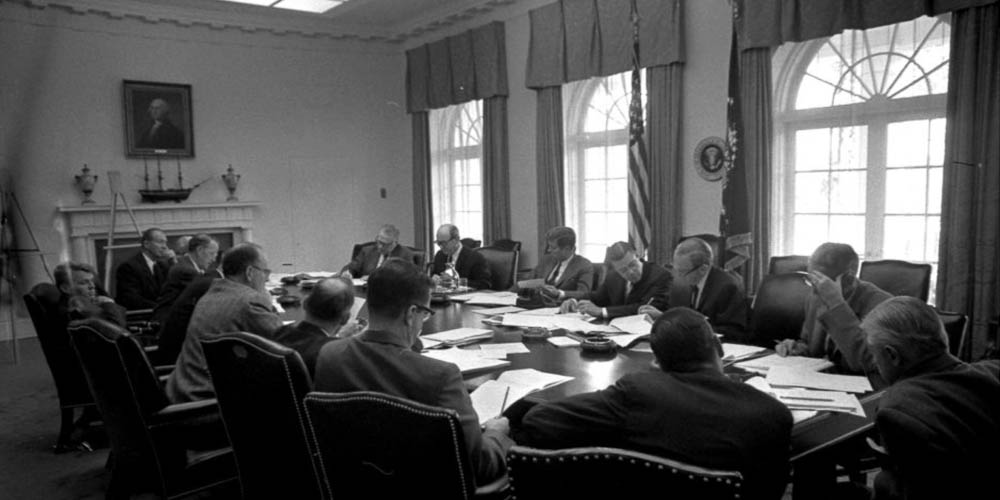 EXCOMM Meeting, Cuban Missile Crisis
EXCOMM Meeting, Cuban Missile Crisis ‘There was no day or night,’ said Mrs. Kennedy.
“The context of the crisis is, as always, critical. In the heart of Europe, Berlin was in play, its fate essential and unknowable. The United States had deployed some Jupiter missiles to Turkey, seemingly shifting the balance of strategic power to American advantage. Nikita Khrushchev, the Soviet leader, wanted to redress that balance and project Soviet power closer to American shores. Cuba was the perfect choice. And Kennedy, in issuing an ultimatum in September saying that the United States could not tolerate such missiles in Cuba—JFK was under attack for appearing weak on foreign policy— was now in a bind.
“The options: immediate air strikes to try to take out the weapons, but no one knew how many of them the U.S. could actually hit or whether the Soviets would immediately strike back. There could be an invasion. There could be a naval blockade. Or there could be diplomacy. No option was good; all risked escalation, either purposely or by miscalculation. The whole crisis was the result of a miscalculation: Moscow had wanted to install the weapons as a largely symbolic show of influence, not so much as a provocative military maneuver. Khrushchev routinely inflated Soviet strength on the grounds that ‘America recognizes only strength.’
“Kennedy, a young man with an abiding interest in history, was skeptical of the advice he received both from the military and from the CIA. The author of two books—Why England Slept, about appeasement, and Profiles in Courage —he was a man of the urgent present intrigued by the past. Perhaps above all he valued experience, and he enjoyed seeing how reality tracked— or failed to—with the assumptions of those outside the arena.
“And he knew how to learn. The resolution of the Missile Crisis was rooted in the disastrous Bay of Pigs invasion of Cuba in 1961. After the botched attack just a few months after his inauguration, Kennedy was horrified by his failure to see the flaws in the planning. ‘How could I have been so stupid?’ he asked himself and others in the aftermath. Fifteen hundred men had been sent to the beaches; later estimates suggested it would have taken a whole division—15,000 men—to conduct a successful amphibious operation of this scope. To a CIA officer he admitted, ‘In a parliamentary system I would resign.'”
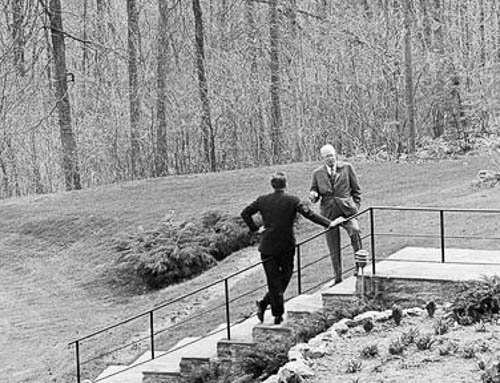 President John F. Kennedy and former President General Dwight D. Eisenhower
President John F. Kennedy and former President General Dwight D. Eisenhower “Eisenhower asked a crucial question. ‘Mr. President, before you approved this plan, did you have everybody in front of you debating the thing so you got the pros and cons yourself and then made the decision, or did you see these people one at a time?’
“Kennedy replied, ‘Well, I did have a meeting… I just approved a plan that had been recommended by the CIA and by the Joint Chiefs of Staff. I just took their advice.’ He would never do that again.
“A cool realist in the tradition of Jefferson, Jackson, Lincoln, and FDR, Kennedy knew, as he put it, that ‘every President must endure a gap between what he would like and what is possible.’ In looking back to the past, Kennedy hoped the realism of his predecessors would make his own pragmatism seem statesmanlike rather than opportunistic. These lessons guided him hour by hour through the Missile Crisis. In a review of a book about military strategy written just a few months before the 1960 presidential election, Kennedy had quoted Basil Liddell Hart:
“Such was the man who managed the Missile Crisis. The stakes could not have been higher. Possible casualty estimates range from 70 million to 100 million Americans. JFK believed the existence of the nation was in the balance.”
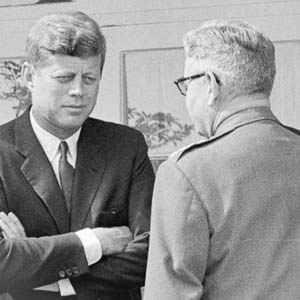 President Kennedy with General LeMay
President Kennedy with General LeMayThe choices were air attack, invasion or blockade. Kennedy thought that if the U.S.attacked Cuba, the Soviets might attack Berlin and that would lead to nuclear war.
“General Curtis LeMay dismissed the president’s concerns. Without an attack on Cuba—not a blockade, but a real attack—the Soviets would see America as fatally weak. ‘It will lead right into war,’ LeMay said. ‘This is almost as bad as the appeasement at Munich.’
“Kennedy was horrified. When LeMay said that the president was in quite a fix, Kennedy asked him to repeat himself. ‘What did you say?’
‘You’re in a pretty bad fix.’
‘Well, you’re in there with me,’ Kennedy said.
“In the debate over air strikes, invasion, and blockade, President Kennedy resisted being seduced by any one faction of his advisers. He knew that each came to the table with preconceptions and interests of their own. Only the two Kennedys—the President and the attorney general—had the ability to see the whole. ‘We are very, very close to war,’ JFK told aides amid the crisis…
“In the end, it was a deal—the exchange of missiles in Cuba for missiles in Turkey—that ended the crisis peaceably. Khrushchev turned out to be a rational actor: he was interested in temporal power, not epic destruction. And President Kennedy, by thinking practically and putting himself in his foe’s shoes, had managed to bring things to a calm finish.”
– Jon Meacham
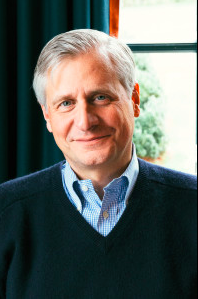 Jon Meacham, author of "The World of Thought and the Seat of Power - The Leadership of John F. Kennedy
Jon Meacham, author of "The World of Thought and the Seat of Power - The Leadership of John F. Kennedy“That was the pragmatic Kennedy.
“His other great gift—that of connecting politics and culture—was on display at Amherst College in the autumn of 1963. It was the kind of occasion that Kennedy loved. Asking Frost to the inaugural had flowed from this vision, as had the White House dinner the president had hosted in the spring of 1962 for all the living recipients of the Nobel Prize from the Western Hemisphere. ‘I think the pursuit of knowledge, the pursuit of peace, are very basic drives and pressures in this life of ours,’ Kennedy had told guests at the Nobel evening, ‘and this dinner is an attempt, in a sense, to recognize those great efforts, to encourage young Americans and young people in this hemisphere to develop the same drive and deep desire for knowledge and peace.'”
Speaking at Amherst, Kennedy’s words were eloquent and memorable:
“‘What good is a private college or university unless it is serving a great national purpose?’ and ‘Privilege is here, and with privilege goes responsibility.’
“Evoking the depth and character of the man Robert Frost, he said,
“He was supremely two things: an artist and an American. A nation reveals itself not only by the men it produces but also by the men it honors, the men it remembers … The men who create power make an indispensable contribution to the nation’s greatness, but the men who question power make a contribution just as indispensable, especially when that questioning is disinterested, for they determine whether we use power or power uses us.”
And poignantly,
“His sense of the human tragedy fortified him against self-deception and easy consolation… He gave his age strength with which to overcome despair.”
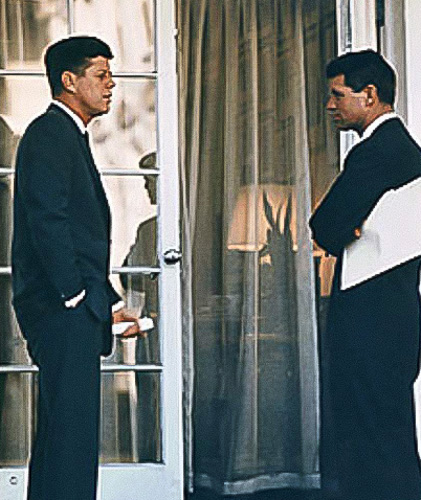 The Attorney General was fully engaged with the President in their civil rights agenda
The Attorney General was fully engaged with the President in their civil rights agendaThe clamor for civil rights for all was becoming more vocal, and the challenges to those who resisted were strengthening. In June 1962, the President and Attorney General Robert Kennedy sought to convince Mississippi Governor Ross Barnett to obey the Court’s decision ordering the University of Mississippi to admit James Meredith. As Barnett blocked Meredith’s registration, the Mississippi National Guard as well as federal marshals were used to protect Meredith and ensure his admission. That fall, rioting occurred outside Meredith’s dormitory resulting in injuries and deaths.3
Activists were disappointed that Kennedy had not asked Congress for a strong civil rights bill, but Kennedy was reluctant to push too hard – recognizing the intense feelings that could bring renewed rioting and not willing to take a strong stand prior to the mid-term elections. Instead, in February 1963, Kennedy proposed a voting rights bill, but still appointed segregationist judges. Martin Luther King, Jr. was frustrated with Kennedy’s lack of leadership – and opined that white moderates were more interested in “order” than in “justice.”
In May 1963, Birmingham, Alabama was the center of the civil rights movement. The treatment of protestors by the Birmingham police was termed “violent cruelty.”
National and international reaction to televised broadcasts of these events forced Kennedy to reassess his position. On top of that, Alabama Governor George Wallace blocked admission to the University of Alabama of two black youth. National Guardsmen were required to enforce their admission, as the Court had ordered.
With these events on the nation’s conscience, Kennedy addressed the nation on June 11, declaring civil rights a moral issue and that black U.S. citizens were entitled to the same rights as all other citizens. Days later, Kennedy sent a thorough civil rights bill to Congress. Civil rights activists continued to make their voices heard and hoped to pressure Congress to move forward. Segregationists continued to press their views and in several instances, perpetrated violence. On October 26, 1963, when President Kennedy visited Amherst College, many students appeared in vigil with placards encouraging the President to more actively support civil rights for all.
4
– Ken Burns speaking of President Kennedy
Emeritus Professor Robert Benedetti was interviewed by the Stockton Record on his remembrances of the assassination of President Kennedy and its aftermath.
“People are more likely now to feel that they have a responsibility because his agenda was cut short. I note that among my fellow graduates, they are becoming more involved in social and political issues.”
The interview has been transferred from the Stockton Record to the Kennedy Library and is on YouTube. Watch the video here.
Steven Olikara, founder of the Millennial Action Project, describes the meaning Kennedy’s words hold for today’s young adults5:
“What was most important about Kennedy’s youth was not how young President Kennedy was or how young his supporters were, but how young his ideas were.
“His ideas were “young” in two senses: their novelty brought hope to the American people and relied on particularly young people to succeed. They also remain young today, replenished by a new generation serving their country, dreaming big, and acting with courage.“
“When I talk to former Governors, Senators, and other public servants who served in the 70s, 80s, and 90s, I often ask them what got them involved in politics. The most common answer I hear is, ‘President Kennedy asked me to serve, and I was inspired to answer that call.’ For many of them, their first experience in public service was as a Peace Corps volunteer.
“This idea of calling on Americans to serve their country and the world was young when President Kennedy delivered it during his inaugural address; I think it must remain replenished by young people today if our democracy is going to thrive for the next generation.”
And his optimistic, future-looking vision was youthful; it resonated with the young.
“He inspired our nation to dream big, to elevate our vision, and imagine what we can do together in common cause with one another… These notions of public service and future-looking vision, exemplified by the Peace Corps and space missions, were young in the 1960s and must remain a core part of young leaders today who are taking up the reins of government.
“I believe the essential challenge we are confronted with is how we pass the proverbial torch to a new generation of leaders in this early century…
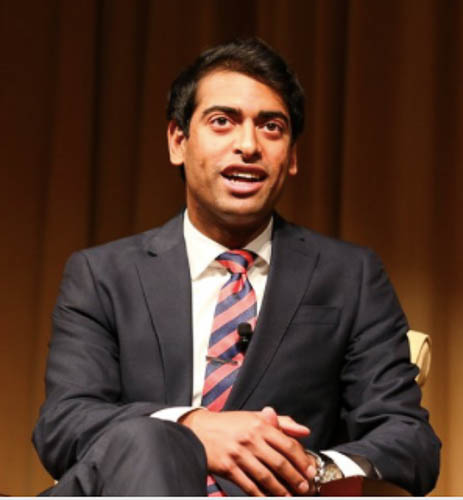 Steven Olikara
Steven Olikara“When I sense people thinking that the challenges are too big, I think about President Kennedy. I believe President Kennedy would want to face these challenges head on and move our country to action. He would want to unleash the innovation of this younger generation, marshalling the public and private sectors to work together to solve climate change, alleviate poverty, to make education more affordable.
“I believe Kennedy’s emphasis on passing the torch is deeply rooted in the American experience. The real genius of the Founding Fathers was to build a political system that is capable of evolving. They made a bet in 1776 on the younger generations of the future changing American politics. That remains a smart bet today.
“Indeed, real political change over the course of American history has been driven by young leaders like President Kennedy. Thomas Jefferson lived to be 83 years old, but he wrote the Declaration of Independence when he was only 33. James Madison lived to be 85 years old, but he was first elected to Congress when he was 29. He wrote our nation’s Constitution when he was 36. Many of the Founding Fathers in 1776 were under the age of 40—we see them as being old because they were wearing powdered wigs and we’ve marbleized them over time…
“The real story of American democracy and American self-government is young leaders driving political transformation—making America more inclusive, more focused on the future. If a generation of 20-somethings and 30-somethings invented American democracy, why can’t a generation of 20-somethings and 30-somethings reinvent American democracy today?
“I hope our generation remembers what President Kennedy said on November 29, 1962: ‘I am certain that after the dust of centuries has passed over our cities, we, too, will be remembered not for victories or defeats in battle or in politics, but for our contribution to the human spirit.’”
– Steven Olikara, Millenial Action Project
On November 25, 1963 Leonard Bernstein, conductor of the New York Philharmonic Orchestra addressed the United Jewish Appeal Benefit. In these brief remarks, he eloquently expressed the regard that the artistic community had for President Kennedy:
“I know of no musician in this country who did not love John F. Kennedy. American artists have for three years looked to the White House with unaccustomed confidence and warmth. We loved him for the honor in which he held art, in which he held every creative impulse of the human mind, whether it was expressed in words, or notes, or paints, or mathematical symbols. This reverence for the life of the mind was apparent even in his last speech, which he was to have made a few hours after his death. He was to have said: ‘America’s leadership must be guided by learning and reason.’ Learning and reason: precisely the two elements that were necessarily missing from the mind of anyone who could have fired that impossible bullet. Learning and reason: the two basic precepts of all Judaistic tradition, the twin sources from which every Jewish mind from Abraham and Moses to Freud and Einstein has drawn its living power. Learning and Reason: the motto we here tonight must continue to uphold with redoubled tenacity, and must continue, at any price, to make the basis of all our actions.”6
More than half a century after he established the Peace Corps, some 225,000 Americans have volunteered around the world — sharing, in the President’s words, “the great common task of bringing to man that decent way of life which is the foundation of freedom and a condition of peace.” Eight years after JFK challenged the nation to land a man on the Moon within a decade — a seemingly impossible goal — two American astronauts left their footprints on the dusty lunar surface. JFK was the first U.S. President to define the issue of civil rights as a moral issue, marking a milestone in the modern civil rights movement. And in one of his most impassioned addresses, delivered in a city square of Berlin that now bears his name, he electrified the crowd of hundreds of of Berliners, as he praised their courage and fortitude and championed the cause of democracy with words that endure today as a ringing defense of freedom:”Ich bin ein Berliner.”7
– President Kennedy’s Remarks for the Opening of a USIA Transmitter8
by Rip Sparks, Amherst ’64
“HOW REMARKABLE IT WAS for a sitting president, in the midst of grave international and domestic issues and a personal tragedy, to spend a beautiful Fall day in 1963 at our small liberal arts college talking to us about the civic and ethical responsibilities of the privileged and the critical role of the arts and artists in the exercise of political power. We now appreciate the respect and gratitude that JFK had for the extraordinary, long-term government service of the Chair of Amherst’s Board of Trustees, John J. McCloy. When McCloy invited the President to speak at the College, in Kennedy’s own words, ‘… there is only one response. So I am glad to be here.’
“The speech JFK gave that day has been characterized as ‘the most majestic speech of his career’, but it can also be understood as making amends for breaking off contact and friendship with Robert Frost prior to the poet’s death in January 1963. Based on documents that were not released to historians for years, in some cases 50 years, we can now appreciate how harmful, in Kennedy’s view, were Frost’s remarks to the press upon his return from a visit in September that included several hours talking with Soviet Premier Nikita Khrushchev. Unknown to Frost, Khrushchev was also pursuing a deliberate policy of brinkmanship by putting nuclear missiles in Cuba and wanted a private channel to assure JFK that the Premier was rational. Khrushchev was also applying his own version of poetry and power, by authorizing publication of Russian writers as part of his de-Stalinization campaign.
“JFK soon learned about the approach of Soviet freighters carrying landbased missiles to Cuba but did not know there were Soviet submarines equipped with nuclear-armed torpedoes to protect the ships from interdiction. Those 13 days in October 1962 were more dangerous than we knew and we now understand how critical it was that Khrushchev not misjudge JFK’s resolve.
“There were big initiatives in space exploration, mental health, and overseas development (Peace Corps, Alliance for Progress) and hopeful visions and actions for equal opportunity and justice at home and for international cooperation in the arts and sciences and conquest of disease.
“The President attended to the mid-term Congressional elections of 1962 and was preparing for the Presidential election of 1964. In midst of all this, John and Jacqueline Kennedy lost their newborn son in August 1963.
 Rip Sparks, Author of Annotated Timeline
Rip Sparks, Author of Annotated TimelineIt was an incredibly event-crowded, inspiring, tumultuous, and dangerous time, yet the President made time to think deeply and speak eloquently about poetry and power in our democracy. The speech he gave that afternoon was … one to come back to, whenever we need a touchstone for our own times.”9
Read the fully annotated timeline. It is available with footnotes and references in the companion text, JFK The Last Speech.
Notes:
1 Jon Meacham, “The World of Thought and the Seat of Power – The Leadership of John F. Kennedy,” JFK: The Last Speech. Mascot Books, 2018.
2 B. H. Liddell Hart, Deterrent or Defense. Frederick A. Praeger, 1960. Hart was an English soldier, and military historian.
3 Larry J. Sabato, The Kennedy Half Century, Bloomsbury, New York. 2013. pp 110-117. This section on civil rights is based on information in the Sabato text.
4 Ken Burns, “JFK Fifty Years Later”, ABC News This Week,November 17, 2013, https://www.youtube.com/watch?v=zXTxXCgwIVM
5 Steven Olikara, “My Dream for America – A New Generation of Leadership,” JFK: The Last Speech, Mascot Books, 2018. Mr. Olikara is founder of the Millennial Action Project, MAP. The Millennial Action Project works directly with the nation’s leading young policymakers on both a national and state level to spur bipartisan legislation and innovative policy solutions.
6 Leonard Bernstein, “Tribute to John F. Kennedy,” Findings, Simon & Schuster, 1982.
7 John F. Kennedy Library Foundation, JFK 100 — Milestones & Momentos, Puritan Press, 2017. p 4
8 President Kennedy’s Remarks Recorded for the Opening of a USIA Transmitter at Greenville, North Carolina, February 8, 1963.
9 Rip Sparks (Amherst ’64), “Annotated Timeline,” JFK: The Last Speech. Mascot Books, 2018.
Photo Credits:
Photograph of the Nation Security Council Executive Committee on October 29, 1962 by Cecil Stoughton. White House Photographs. John F. Kennedy Presidential Library and Museum, Boston. Public Domain.
President John F. Kennedy and Former President General Dwight D. Eisenhower Meet at Camp David on April 22, 1961. Photograph by Robert Knudsen. White House Photographs. John F. Kennedy Presidential Library and Museum, Boston. Public Domain.
President John F. Kennedy with General Curtis E. LeMay on October 1, 1962. Photograph by Cecil Stoughton. White House Photographs. John F. Kennedy Presidential Library and Museum, Boston. Public Domain.
Jon Meacham website photo.
Steven Olikara, Founding President of the Millennial Action Project, Washington, D.C. Picture source: https://www.millennialaction.org/steven-olikara/
Rip Sparks, Photo courtesy of Reunion ’64, Inc.